Complete Solutions to Excretory Products And Their Elimination of chapter EXCRETORY PRODUCTS AND THEIR ELIMINATION of Class 11 book with complete answers and questions
| Class 11 | BIOLOGY |
| Chapter | EXCRETORY PRODUCTS AND THEIR ELIMINATION |
| NCERT FINGERTIPS | Excretory Products And Their Elimination |
| Number Of Questions | 100 |
| Academic Year | 2023-24 |
Which of the following is the most toxic excretory product?
02:07View SolutionAlmost all the aquatic animals excrete ammonia as the nitrogenous waste product. Which of the following statements is not as agreement with this situation?
03:26View SolutionThe principal nitrogenous excretory compound in humans is synthesized
02:47View SolutionWhich one of the following options gives the correct categorisation of animals according to the type of nitrogenous waste they give out?
02:17View SolutionWhich of the following pairs of organisms are uricotelic?
01:45View SolutionWhich of the following groups contains uricotelic animals only?
02:32View SolutionWhich one of the following options shows a correct matching pair?
02:07View SolutionThe char5acteristic(s) common to urea, uric acidn and ammonia is/are
(i). Theya re nitrogenous wastes.
(ii). They all need very largwe amount of water for excretion.
(iii). They are all equally toxic.
(iv). They are produced in the kidneys03:03View SolutionMatch column I with column II and select the correct option from the codes given below
`{:("Column I","Column II"),(A." Nephridia",(i)." Crustaceans"),(B." Malpighian tubules",(ii)." Annelids"),(C." Anetennal gland or green glands",(iii)." Insects"):}`02:23View SolutionSelect the correct option representing the excretory organs present in (i) earthworm, (ii) centipede, (iii) prawn, and (iv) flatworm.
02:47View SolutionWhich one of the following organisms is correctly matched with its excretory organs?
02:33View SolutionWhich of the following statements is incorrect?
02:34View SolutionRefer to the given figure of human urinary system and select the option that correctly identifies the labelled parts A to E.
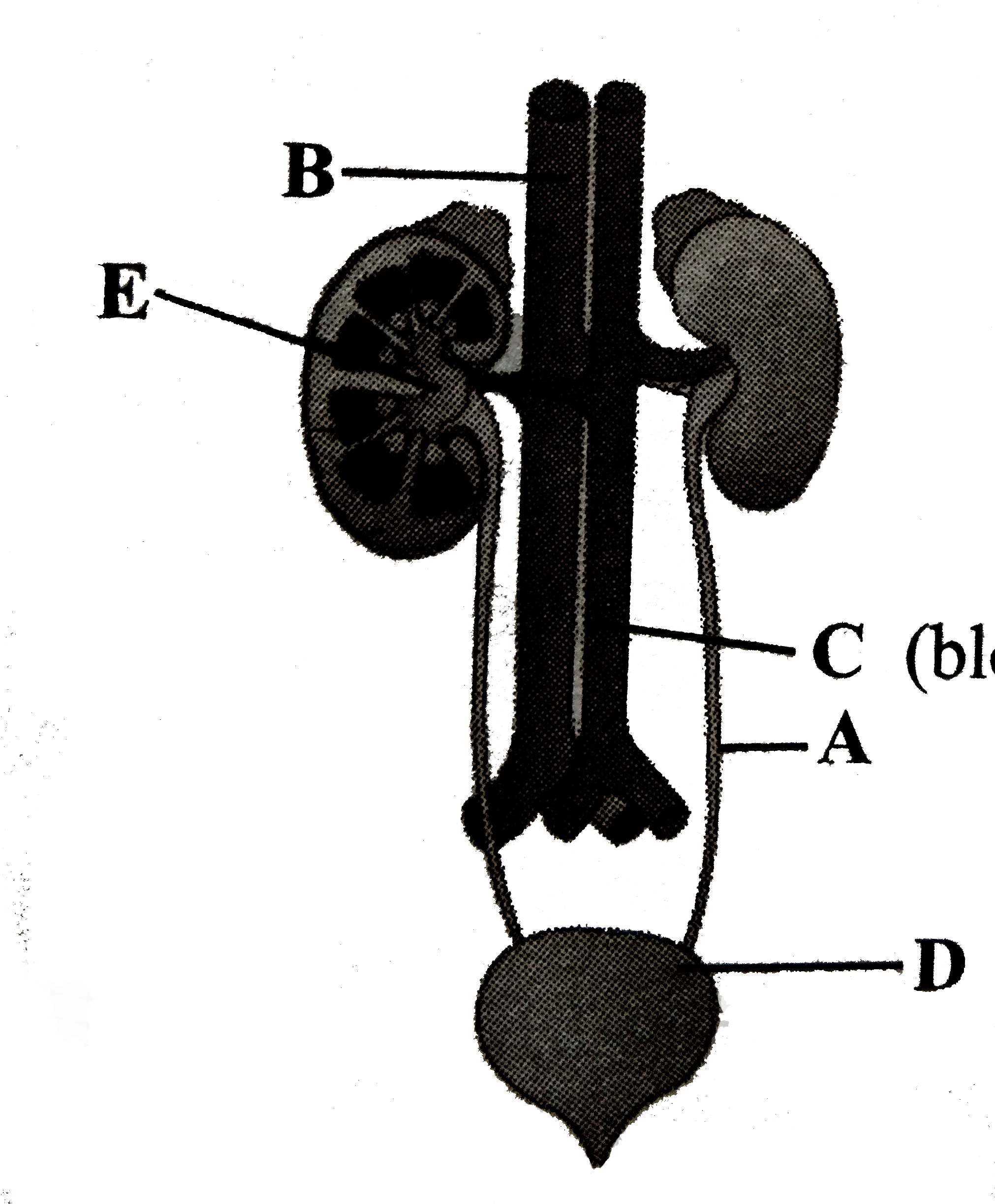 02:02View Solution
02:02View SolutionWhich of the following options shows the correct measurements of an adult human kidney?
03:23View SolutionWhich of the following is the correct pathway for passage of urine in humans?
03:38View SolutionStatement-1: The uriniary bladder dilates a good deal as urine trickles into it from the ureters.
Statement-2: Urinary bladder is lined throughout by transitional epithelium04:39View SolutionA notch present on the inner medial side of kidney is
02:09View Solution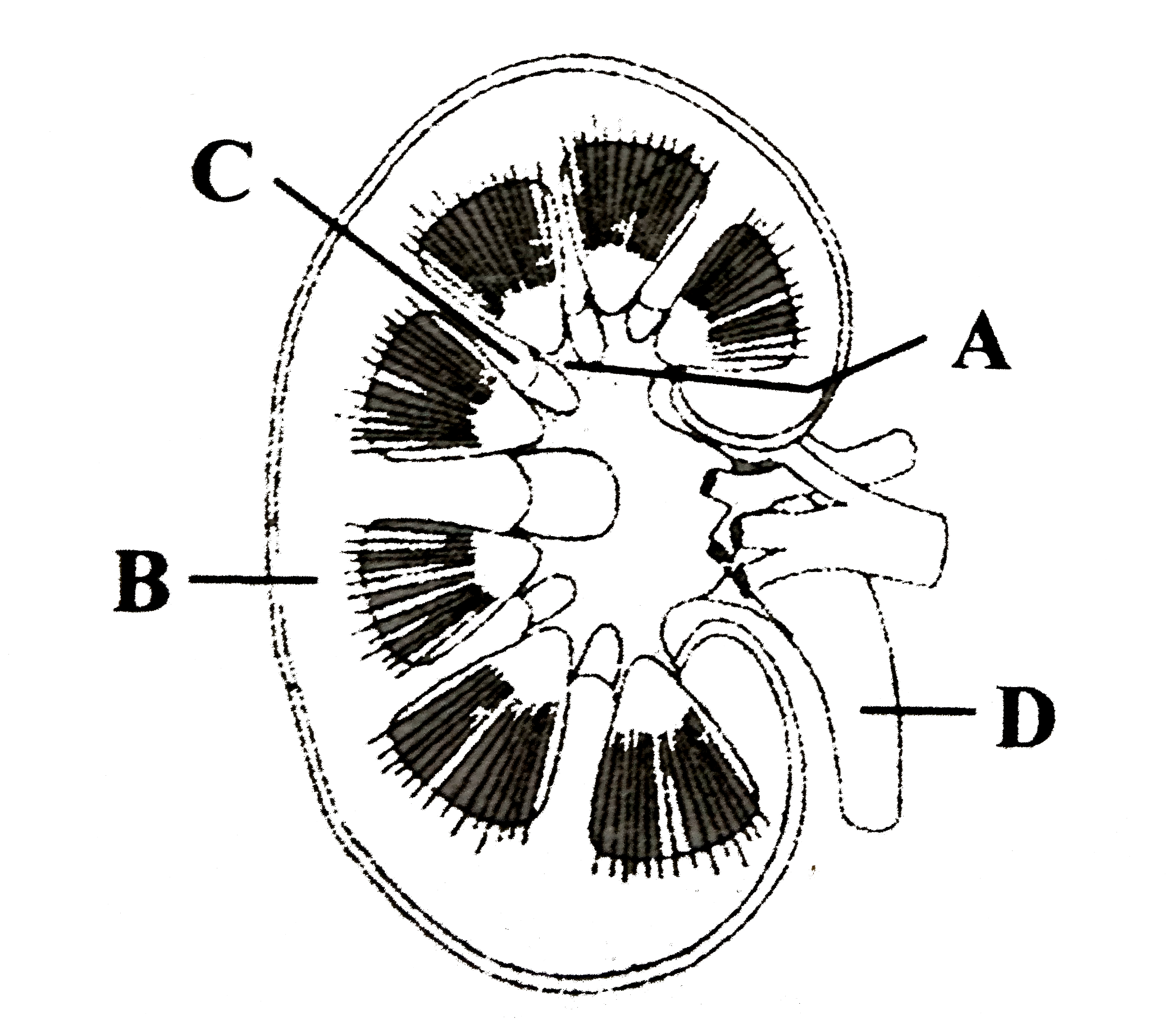
Given figure is of longitudinal section of kidney. Identify the parts labelled as A to D and select the correct option.04:05View SolutionWhich of the following statements are false?
(i). Outer cortex and inner medulla are the two zones in kidney.
(ii). Medulla is divided into few renal pyramids.
(iii). Pyramid projects into calyx.
(iv). Inward extension of cortex between the pyramids is called renal column of bertini.03:27View SolutionColumns of bertin in the kidneys of mammals are formed as extensions of
01:27View SolutionWhich one of the following is not a part of renal pyramid?
02:02View SolutionThe basic functional unit of human kidney is
01:43View SolutionConsider the following statements each with one or two blanks.
(i). Towards the centre of the inner concave surface of the kidney is a notch called (1) through which ureters, blood vesels and nerves enter.
(ii). The medulla of kidney is divided into a few conical masses called (2) projecting into the (3).
(iii). Glomerulus is a tuft of capillaries formed by the (4). artery. Blood from the glomerulus is carried away by an (5) artery.
Which one of the following options correctly fills the blanks in any two of the statements?03:54View Solution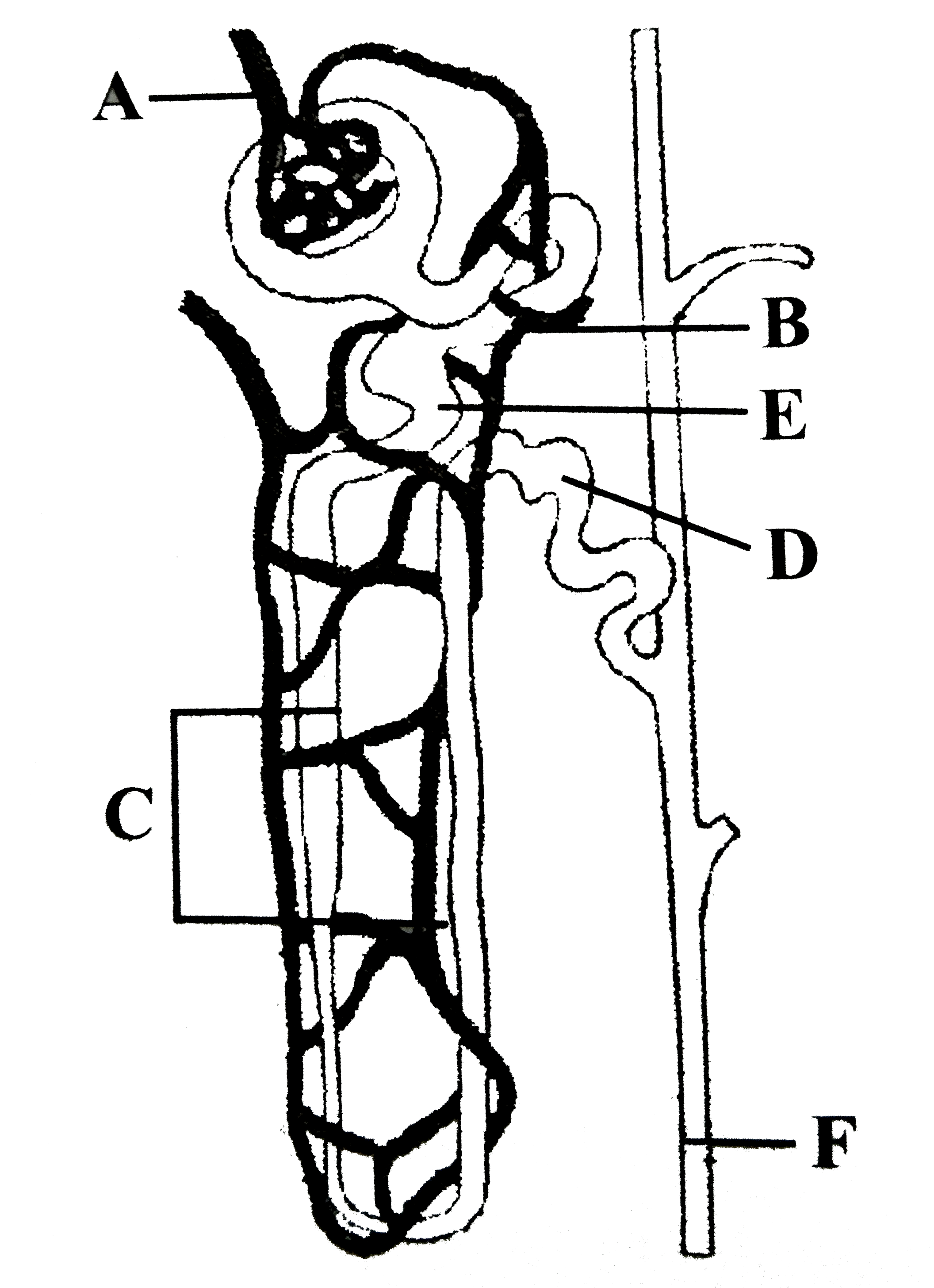
Select the options that correctly identifies the parts labelled from A to F in the given fiture of nephron.03:33View Solution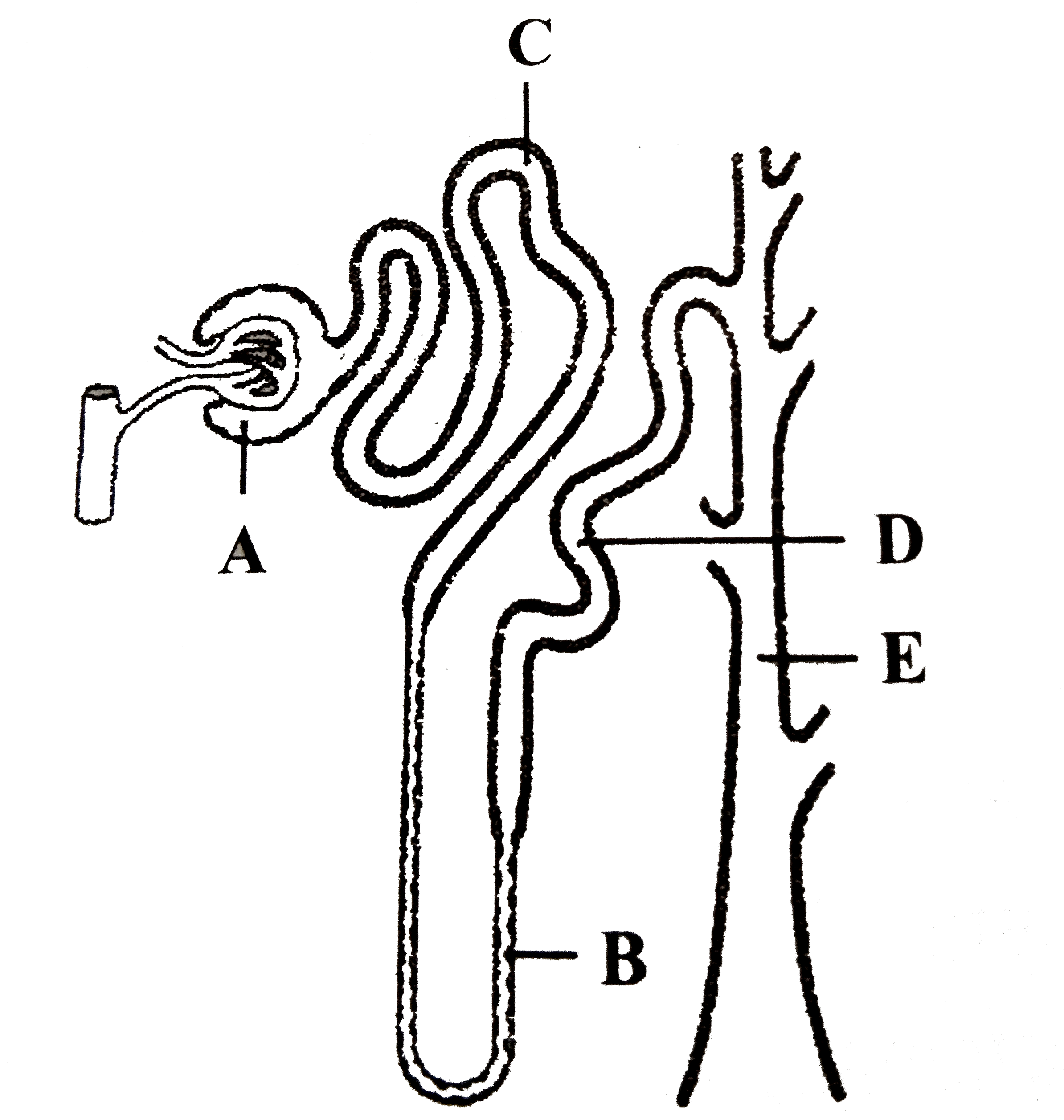
The given figure represents a single nephron from a mammalian kidney. Identify the labelled parts, match them with the functions (i-iv) and select the correct option.
(i). The site of ultrafiltration.
(ii). Particularly sensitive to ADH.
(iii). The main site for the reabsorption of glucose and amino acids.
(iv). Largely responsible for the maintenance of blood pH.04:18View SolutionWhich of the following is not correct with respect to human kidney?
03:01View SolutionThe bunch of capillaries present in the Bowman's capsule is called
01:26View SolutionA Malpighian body is constituted by
01:38View SolutionWhich of the following statements is correct?
02:23View Solution
The given figure represetns the Malpighian body. Identify the labelled parts A to D and select the correct option.02:17View SolutionThe number of nephrons in a kidney is equal to
02:38View SolutionWhich of the following statements is correct?
02:17View SolutionWhich one fo the following does not constitute a part of single uriniferous tubule?
01:23View SolutionMatch column I with column II and select the correct option form the codes given below.
`{:("Column I","Column II"),(A." Delivers blood to glomerulus",(i)." Ascending and descending limbs"),(B." Carries urine to pelvis",(ii)." Renal artery"),(C." Collects filtrate from Bowman's capsule",(iii)." Collecting duct"),(D." Loop of Henle",(iv)." PCT"):}`03:16View SolutionThe dotted appearance of cortex of kidney is due to
01:29View SolutionAll Bowman's capsules of the kidney are found in
01:32View SolutionThe longest loop of Henle is found in
02:59View SolutionOf the total nephrons, juxtamedullary nephrons constitute.
01:41View SolutionWhich of the following is the correct sequence of processes involved in urine formation?
02:43View SolutionLiquid which collects in the cavity of Bowman's capsule is
01:36View SolutionEffective filtration pressure in glomerulus is caused due to
02:09View SolutionThe net pressure gradient that causes the fluid to filter out of the glomeruli into the capsule is
02:33View SolutionComplete the following paragraph by selecting the option that correctly fils the blanks (i)- (iv) The kidney have built-in mechanisms for the regulation of glomerular filtration rate. One such efficient mechanism is carried out by (i)._____ It is a special sensitive region formed by cellular modifications in the (ii)._________ and the (iii)._________ at the location of their contact. A fall in GFR can activate the JG cells to release (iv).________ which can stimulate the glomerular blood flow the thereby brings GFR back to normal
01:38View SolutionA fall in glomerular filtration rate (GFR) activates
05:09View SolutionJuxtaglomerular apparatus is made up of
02:59View SolutionA large quantity of fluid is filtered everyday by nephrons in the kidneys but only about 1% of it excreted as urine. The remaining 99% of the filtrate
02:07View SolutionHippuric acid, creatinines and ketonews are added to urine through
02:06View SolutionThe maximum amount of electrolytes and water (70-80 per cent) from the glomerular filtrate is reabsorbed in which part of the nephron?
02:07View SolutionWhich of the following is removed from the filtrate at loop of Henle?
01:34View SolutionRead the given statements and identify the structure referred here.
(i). Reabsorption in this region in minimum.
(ii). This region plays a significant role in the maintenance of high osmalarity of interstitial fluid.
(iii). Its descending limb is permeable to water but almost impermeable to electrolytes.
(iv). Its ascending limb is impermeable to water but allows transport of electrolytes actively ro passively.01:59View SolutionWhich of the following statements are correct?
(i). Renal vein takes blood away from kidney.
(ii). Unine gets diluted in ascending limb of loop of Henle.
(iii). Podocyte occur in inner wall of Bowman's capsule.
(iv). Ultrafiltrate/nephric filtrate is plasma minus proteins.02:43View SolutionSelect the correct option representing the parts of nephron that respectively absorb (i).______ glucose, (ii)._____amino acids,
(iii).______inorganic ions `(Na^(+),K^(+),Cl^(-))` and (iv).____urea in maximum.02:39View Solution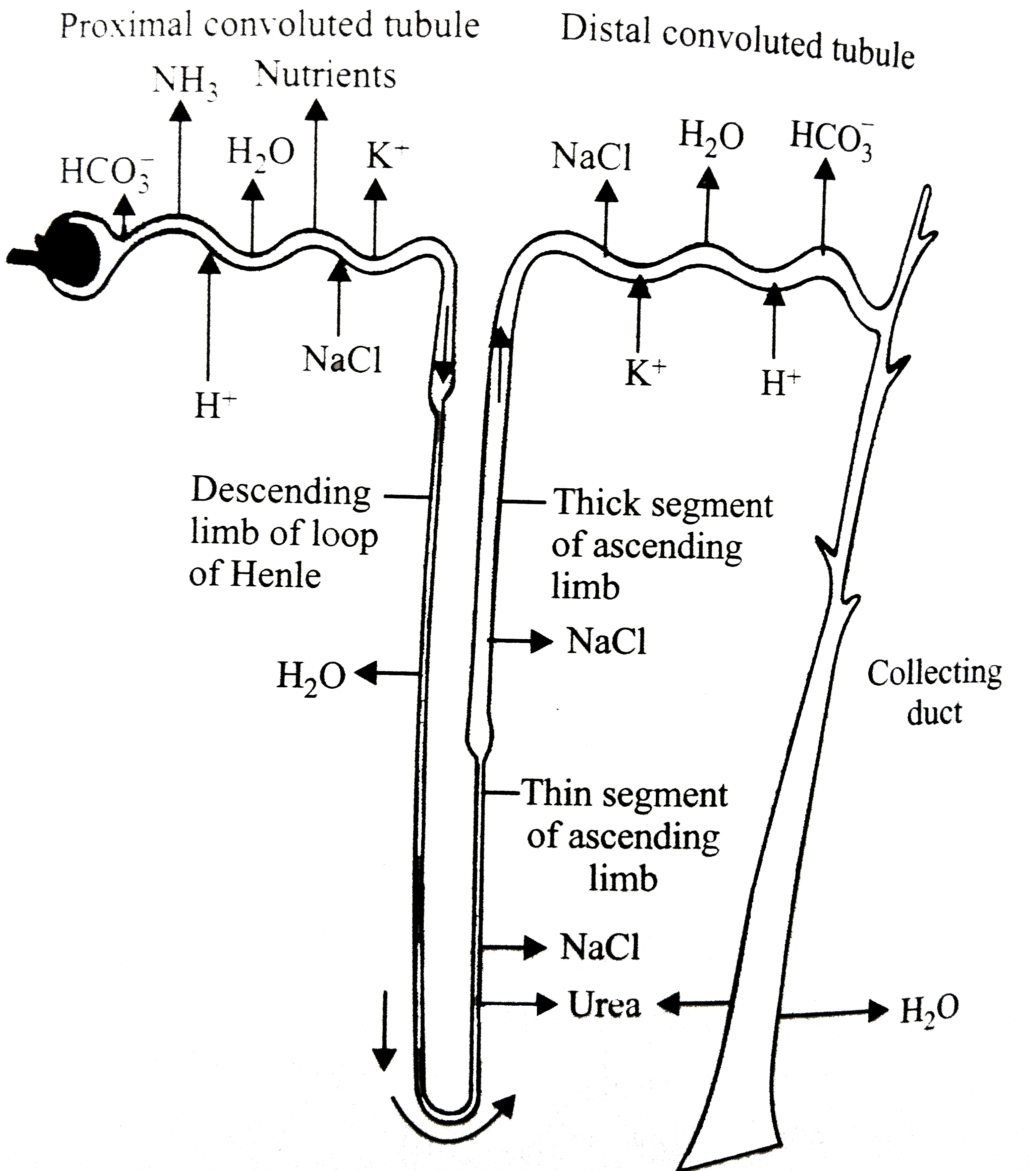
The given figure shows reabsorption and secretion of major substances at different parts of the nephron. The movelment of which of the following substances is wrongly depicted?02:45View SolutionWhich one of the following statements in regard to the exretion by the human kidneys is correct?
03:07View SolutionExretion of potassium is governed primarly by
01:38View SolutionWhich one of the following is a correct pair showing the function of a specific part of the human nephron?
02:55View SolutionWhich of the following statements are correct?
(i). Reabsorption of water occurs passively in the initial segment of nephron.
(ii). Nitrogenous wastes are absorbed by passive transport.
(iii). Conditional reabsorption of `Na^(+)` and water takes palce in DCT.
(iv). DCT reabsorbs `HCO_(3)^(-)`
(v). DCT is capable of selective secretion of `H^(+),K^(+)` and `NH_(3)` to maintain pH and `Na^(+)-K^(+)` balance in blood.
(vi). Substance like glucose, amino acids, `Na^(+)`, etc,. it the filtrate are reabsorbed actively.03:06View SolutionWhich of the following is an incorrect match?
02:19View SolutionLong ducts of collecting tubules extend from
01:26View SolutionWhich of the following options has the correct pair of nephron parts that maintain pH and ionic balance of blood?
02:55View SolutionWhich of the following statements is/are incorrect regarding the collecting duct?
(i). It extends from the cortex to medulla.
(ii). Large amount of water could be reabsorbed by it to produce concentrated urine.
(iii). Small amount of urea diffuses into it from the medulla to keep up the osmolarity.
(iv). it plays a role in maintaining pH and ionic balance of blood by the selective secretion of `H^(+)` and `K^(+)` ions.03:22View SolutionMatch column I with column II and select the correct option from the codes given below.
`{:("Column I","Column II"),(A." PCT",(i)." Minimum reabsorption"),(B." DCT",(ii)." Filtration of blood"),(C." Loop of Henle",(iii)." Reabsorption of 70-80% electrolytes"),(D." Counter current mechanism",(iv)." Ionic balance"),(E." Renal corpuscle",(v)." Maintenance of concentration gradient in medulla"):}`03:21View SolutionSelect the incorrect statement regarding mechanism of urine formation in man.
02:55View SolutionWhich of the following statements is incorrect?
03:37View SolutionStatement-1: The final reabsorption of water from the urine into the blood occurs through the collecting duct of a mammalian nephron resulting in thhe production of hyperosmotic urine.
Statement-2: The loop of henle creates a sodium gradient in the interstitial fluid.05:15View SolutionStatement-1: Small amount of urea enters the thick segment of Henle's loop which is tranported back to interstitium by collecting tubules.
Statement-2: Collecting tubules and thick segment of Henle's loop are permeable to urea.05:01View SolutionThe ability of producing concentrated (hypertonic) urine in vertebrates generally depends on
03:04View Solution
Refer to the given figure and select the correct option representing the osmolarity at P,Q,R and S.03:06View SolutionWhich of the following statements is incorrect?
02:41View SolutionPick the odd ones in each of the following groups and select the correct option
(i). Renal pelvis, Medullary pyramid, Renal cortex, Renal papilla
(ii). Afferent arteriole, Henle's loop, Vasa recta, Efferent arteriole
(iii). Glorerular filtration, antidiuretic hormone, Hypertonic urine, collecting duct
(iv). Proximal convoluted tubule, distal convoluted tubule, Henle's loop, Renal corpuscle04:28View SolutionDiuresis is the condition in which
02:03View SolutionWhich of the following sequences is correct regarding regulation of kidney function?
03:06View SolutionWhich someone drinks lot of water, ADH release is suppressed.
03:51View SolutionConsider the following statement each with one or two blanks.
(i). The ascending limb of loop of Henle is impermeable to (1).____but allows transport of (2)._____
(ii). (3)._____and (4)._____play a significant role is producing a concentrated urine.
(iii). A fall in glomerular blood flow/glomerular blood pressure/GFR can activate the JG cells to release (5)._____
Which one of the following options correctly fills the blanks in any two of the statements?02:36View SolutionWhich of the following sequences is correct?
03:43View SolutionThe function of renin is
03:47View SolutionThe reabsorption of the sodium from glomerular filtrate is regulated by the hormone
03:29View SolutionAngiotensinogen is a protein produced and secreted by
01:45View SolutionIn urinary system, aldosterone takes part in retention (reabsorption) of
04:50View SolutionWhat will happen if the stretch receptors of the urinary bladder wall are totally removed?
05:28View SolutionConsider the following statement each with two blanks.
(i). Annelids have (1).____and insects have (2).____for excretion.
(ii). Blood enters the glomerulus via (3)._____arteriole and leaves via (4).____arteriole
(iii). During micturition the urinary bladder (5)._____ and the urethral sphincters (6).______
Which one of the following options correcty fills the blanks in any two of the above statements?04:19View SolutionConsider the following four statements (i).(iv) and select the option that correctly identifies the true (T) and false (F) ones.
(i). Micturition is carried out by a reflex.
(ii). ADH helps in water elimination making the urine hypotonic.
(iii). Protein-free fluid is filtered from blood plasma into the bowman's capsule.
(iv). Glucose is actively reabsorbed in the proximal convoluted tubule.03:43View SolutionThe outline of principal events of urination is given below in random manner.
(i). Stretch receptors on the wall of urinary bladder send segnals to the CNS.
(ii). The bladder fills with urine and becomes distended.
(iii). Micturition.
(iv). CNS passes on motor messages to initiate the contraction of smooth muscles of bladder and simultaneous relaxationf of urethral sphincter.
The correct sequence of the event is04:46View SolutionThe yellow colour of urine is due to the presence of
02:14View SolutionWhich one of the following is correct for a normal human?
04:58View SolutionGlycosuria is the condition, where a man
03:47View SolutionA person is undergoing prolonged fasting. His urine would contain abnormal quantities of
04:20View SolutionA person who is not taking food or beverages will have ______in urine.
02:27View SolutionRead the given statements regarding human excretory system and select the correct ones.
(i). Presence of glucose in urine is known as uremia.
(ii). Distal convoluted tubule (DCT) selectively secretes hydrogen ions, ammonia and potassium ions into the filtrate.
(iii). Macule densa is formed by cellular modification in the distal convoluted tubule and the afferent arteriole at their contact location.
(iv). Atrial natriuretic factor (ANF) can cause vasoconstriction when blood flow is low to the atria of the heart.04:28View SolutionMatch column I with column II and select the correct option from the codes given below
`{:("Column I","Column II"),(A." Lungs",(i)." Lactic acid"),(B." Liver",(ii)." Hypertonic urine"),(C." Micturition",(iii)." Counter-current system"),(D." Sweat",(iv)." "CO_(2)),(E." Vasa recta",(v)." Urinary bladder"),(F." Sebum",(vi)." Glucose"),(G." ADH",(vii)." Bilirubin"),(H." Tubular reabsorption",(viii)." Sterols"):}`07:37View SolutionConsider the following four statements (i-iv) and select the option that correctly identifies the true (T) and false (F) ones.
(i). Atrial natriuretic factor can cause vasodilation (dilation of blood vessels) and thereby decreases the blood pressure.
(ii). On an average, 60-70 gm of urea is excreted out per day.
(iii). Sebaceous glands eliminate certain substances like NaCl, urea and lactic acid through sebum.
(iv). PCT is lined by simple cuboidal brush border epithelium which increases the surface area for reabsorption.04:20View SolutionWhich of the following statements are correct?
(i). Glucose has high threshold value.
(ii). Urine is concentrated in Henle's loop
(iii). Haemodialyser removes urea, uric acid, glucose and plasma prteins
(iv). In glomerulus, urea, uric acid, water, glucose and plasma proteins.
(iv). In glomerulus, urea, uric acid, water, glucose and plasma proteins ar filtered out.06:23View SolutionIn peritoneal dialysis
05:27View SolutionMatch column I with column II and select the correct option from the codes given below ltBrgt `{:("Column I","Column II"),(A." Uremia",(i)." Ketone bodies in urine"),(B." Ketonuria",(ii)." Artificial kidney"),(C." Glycosuria",(iii)." Glucose in urine"),(D." Blood dialyser",(iv)." Accumulation of urea in blood"):}`
04:35View SolutionWhich one of the following is correct with reference to haemodialysis?
06:21View SolutionAn X-ray of the lower abdomen shows a shadow in the region of the ureter suspected to be a ureteric calculus. A possible clinical symptom would be
03:33View SolutionWhat will happen if one kidney is removed from the body of a human poisoning
02:22View SolutionRenal calculi refers to the condition in which
02:15View SolutionGlomerulonephritis is
02:42View SolutionWhich one of the following is not normally excreted in urine?
02:21View Solution
Excretory Products And Their Elimination questions and complete solutions for chapter EXCRETORY PRODUCTS AND THEIR ELIMINATION of MTG BIOLOGY (HINGLISH) of Class 11
